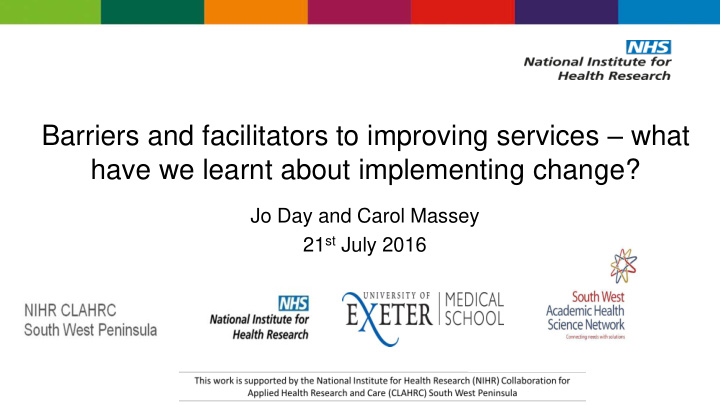



Barriers and facilitators to improving services – what have we learnt about implementing change? Jo Day and Carol Massey 21 st July 2016
Background The often documented chasm between ‘ knowing ’ and ‘ doing / improving ’ health services and the importance of contextual factors. ASPIC Study: Our aim is to generate in-depth insights across the implementation and improvement processes of two SW AHSN / PenCLAHRC projects: Stroke Thrombolysis Pathway and Patient Initiated Clinics in the South West Stroke Quality Improvement Manager: Worked collaboratively - SCN, PenCLAHRC, SW AHSN and Trusts to: promote quality improvement of the Thrombolysis pathway and develop understanding of key factors affecting quality improvement and implementation CLAHRC South West Peninsula (PenCLAHRC)
Methodology Focused Ethnography: “focus on a distinct issue or shared experience in cultures or sub -cultures in specific settings rather than entire communities” (Cruz & Higginbottom 2013, p.36). Suitable for health care research as a pragmatic and efficient way to capture data on a topic of importance. CLAHRC South West Peninsula (PenCLAHRC)
Methodology Implementation Science: Consolidated Framework for Implementation Research (CFIR) by Damschroder et al (2009). Developed by consolidating constructs found in other published implementation theories, models and frameworks: 5 domains – intervention characteristics, inner and outer setting, characteristics of individuals, process 41 constructs An overarching model that aims to help assess what works, where and why across multiple contexts. Used to inform design and analysis of the study. CLAHRC South West Peninsula (PenCLAHRC)
Data ASPIC Study 41 project related documents 45 observations of meetings & Trust visits, formal / informal conversations c.39 hrs 12 interviews - Trusts and Steering Group CLAHRC South West Peninsula (PenCLAHRC)
Insight 1: Outer context - Benefits of improving - Potential for patient outcome of patients Patient harm quality of life and their Needs disability & Not a ‘risk free’ - resources treatment - Seeing the benefit of the treatment for patients after Moving towards implementation and improvement CLAHRC South West Peninsula (PenCLAHRC)
Insight 2: Inner context - External attention e.g. - Focus on other wider CQC aid prioritising priorities such as bed improvement management, finance, Implementation Success Regime Climate: - Perceived as Relative Priority important to do at this - Priority for point in time and have improvement on energy and time to another part of the devote to it stroke pathway Moving towards implementation and improvement CLAHRC South West Peninsula (PenCLAHRC)
Insight 3: Inner context - Where managers and - Trust supportive of clinicians tend not to making coalesce to make improvements – in improvements words and action Culture - Limited resource, - Board has a good money or time put awareness of towards service stroke improvement Moving towards implementation and improvement CLAHRC South West Peninsula (PenCLAHRC)
Insight 4: Inner context - Person - Team Stability - Position - Process Readiness for ‘Our patients are - Implementation: different’ Leadership - Project Drivers Engagement - Catalyst Moving towards implementation and improvement CLAHRC South West Peninsula (PenCLAHRC)
Improvement Leadership • Engaging others as partners • Developing and achieving a shared focus / vision • Create a supportive environment for creative thinking • Challenge assumptions – in a positive way • Appreciate a variety of perspectives • Develop processes that inspire and enable everyone to participate • Make time for reflection CLAHRC South West Peninsula (PenCLAHRC)
Additional challenges • It will probably be harder and longer than you think - ‘be prepared for the unexpected’. Links to reflection and stepping back. • The influence of (his)story - ‘soft’ knowledge / intelligence as well as ‘hard’ measures. The ‘nature’ of each organisation is different. • Recurring need to reinvent the (innovation) wheel and understanding how improvements may work. Evidence in one’s ‘own back yard’ . • Improvement support – how able to network and learn from others CLAHRC South West Peninsula (PenCLAHRC)
Implications & reflections • Possibilities offered by the FE method and CFIR for gaining insights into the role of context in implementation and improvement processes. • Our analysis confirms the mediating influence of a dynamic context and the importance of leadership. A future challenge is to understand the combined influence of factors. • Identify transferable insights for future efforts that are useful for those trying to close the ‘ knowing-doing ’ gap CLAHRC South West Peninsula (PenCLAHRC)
Thank you for listening!
Recommend
More recommend